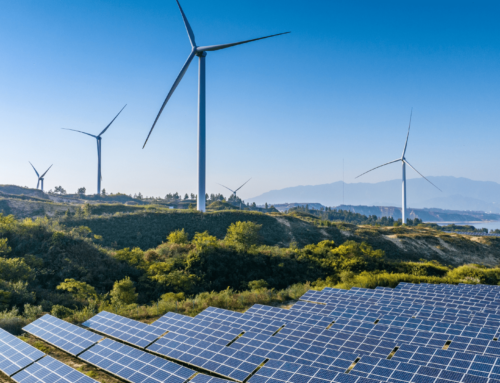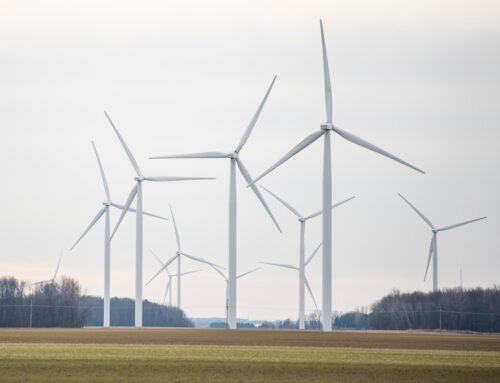As Solar Booms in the California Desert, Locals Feel ‘Overburdened’
October 16, 2024
RIVERSIDE, Calif.—For four hours, Mark Carrington sat quietly with his neighbors at the front of his county’s supervisors’ late August board meeting, waiting for his chance to speak.
They were there for the final agenda item: a vote from the county board of supervisors to approve Intersect Power’s Easley Solar Project, which would span 3,600 acres of private and public lands and generate up to 400 megawatts of solar energy and have 650 megawatts of battery storage capacity, enough energy for 253,000 California homes.
To attend the meeting, Carrington and his neighbors had driven more than two hours from their homes in Desert Center and Lake Tamarisk, unincorporated communities of Riverside County not far from Palm Springs, where solar farms stretch for miles along Interstate 10 in one of the densest areas of photovoltaic panel development in North America.
Desert Center is nearly perfect for solar energy projects. When the nation began looking to transition away from the fossil fuels driving climate change, nearly half of the federal lands currently designated as areas for solar development were found in the Riverside East area Carrington and the neighborhood group he helps lead—the Active Community of Desert Center—call home. The same plan that opened up Desert Center for solar development is now being updated, with the Bureau of Land Management nearing a decision on making up 31 million acres of land across 11 states available for possible new projects. The goal, federal officials, developers and environmentalists say of the planning, is to avoid conflict.
But Desert Center shows how such tensions are almost impossible to avoid.
After hours of waiting, Carrington took the mic.
He outlined the community’s proposed alternative. They want a buffer zone to protect their viewscape and other proposed developments in the area, like new housing and a gas station, which they worry will disappear if the solar is too close. To safeguard the community, he said, they were asking the county, the only local representatives they have as an unincorporated community, to cut 20 megawatts of power from the project.
“We’re saying yes to renewable energy. We’re saying yes to saving the planet,” he said. “Just not at the expense of our communities.”
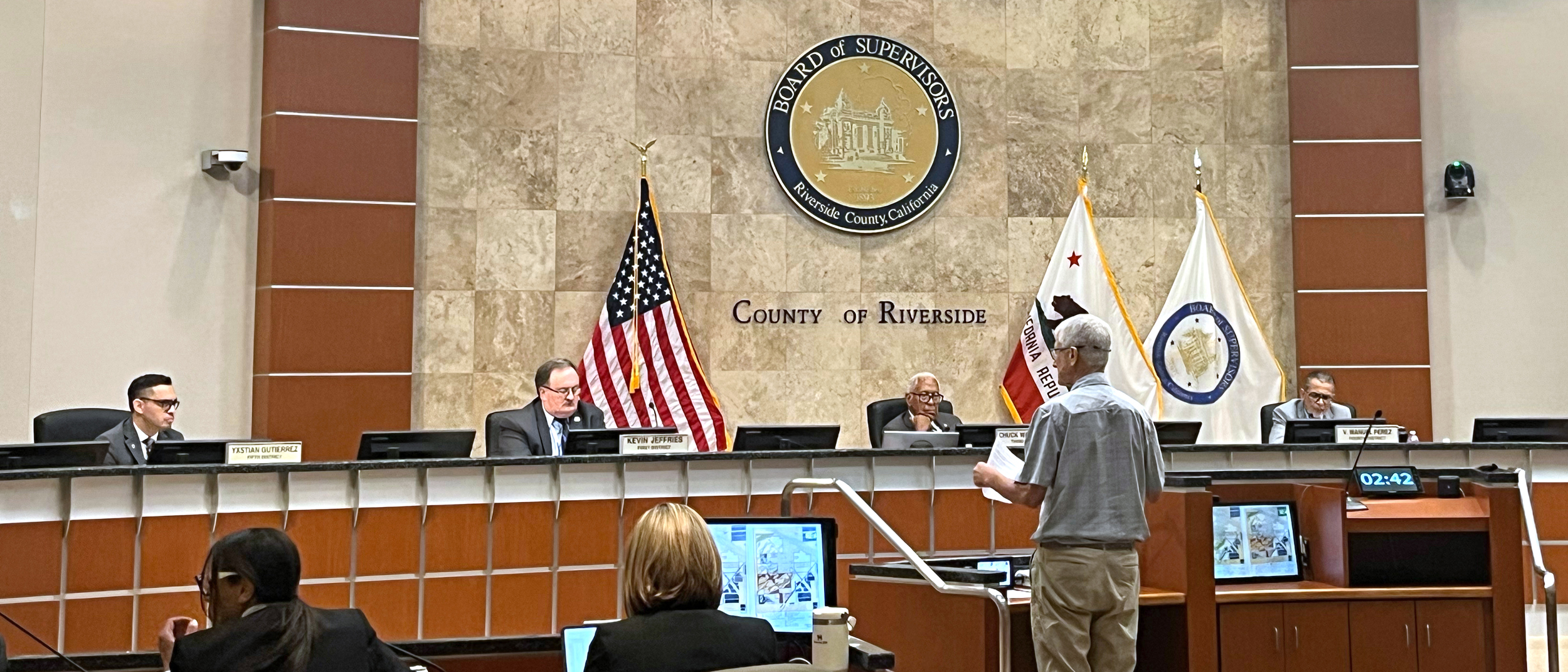
As the solar farms kept coming, the locals, many of whom never knew the area around them had been designated for solar, began to push back. The development had eaten away at the desert they love, impacting desert tortoise habitat, and would now surround their community on three sides. The dust from the construction posed health concerns, and keeping it down with groundwater led local wells to run dry—something federal regulators approving the projects knew for years could happen.
So when the locals learned two more utility-scale solar projects were proposed near them, they got involved with the permitting process—not to stop them, but to make sure their concerns were addressed. They even crafted their own alternative plan for the Easley Solar project with a one-mile buffer around the Lake Tamarisk community, visual mitigations and other modifications. It was designated as the environmentally superior choice during the county’s permitting process.
Over two years, the residents navigated the complicated world of permitting energy projects and the lengthy environmental reviews they go through at the state and federal levels, spending hundreds of hours working on their plan.
The county’s planning department recommended approving the project with some, though not all, of the community’s concerns mitigated. The board meeting was one of the last steps in approving the project.
The hearing continued for two and a half more hours after Carrington spoke. A developer looking to build more homes in the community complained that they would be 100 feet away from the solar panels if Intersect Power’s plan was completed. Members of unions representing the workers that would be employed on the project spoke in favor of it. Representatives from the company highlighted how it had worked with the community over the years and drastically changed the project from its initial plan in response to their input.
At one point, Supervisor V. Manuel Perez, who represents the area, proposed continuing the hearing the following month to allow further analysis of the project’s impacts on the proposed developments in the area. Camille Wasinger, Intersect Power’s senior director of environmental and permitting, quickly interjected that any further delay “would kill the project” —along with the $135 million dollars in taxes and fees set to go to Riverside County, and 540 jobs, the vast majority of which would be in the construction of the project.
The company had already removed 50 acres of panels, setting the project back half a mile from existing Lake Tamarisk homes, and moved the project’s substation further away as well. Water consumption was down 200 acre feet from their original plan, they said—the project now requires 800 acre feet over its two-year construction period. The company had invested $350,000 in the community and committed a total of $3.5 million.
But some of the community’s requests were impractical, she said. Berms built around the solar field to mitigate its visual impacts would create flood concerns. Further downsizing of the project would make the project uneconomical.
Board Chair Chuck Washington was overwhelmed by the flood of information. He didn’t even know the community had proposed its own plan, and didn’t think the county’s planning department had analyzed it; staff quickly corrected him. When Wasinger told him the environmental report was four thousand pages in total, he responded, “I haven’t finished getting through it yet.” The attendees laughed, except for the ones who would live next to the project.
“No one wants to see these in their backyard,” Perez said as he and the rest of the supervisors prepared to vote. “I guess this area is no different.”
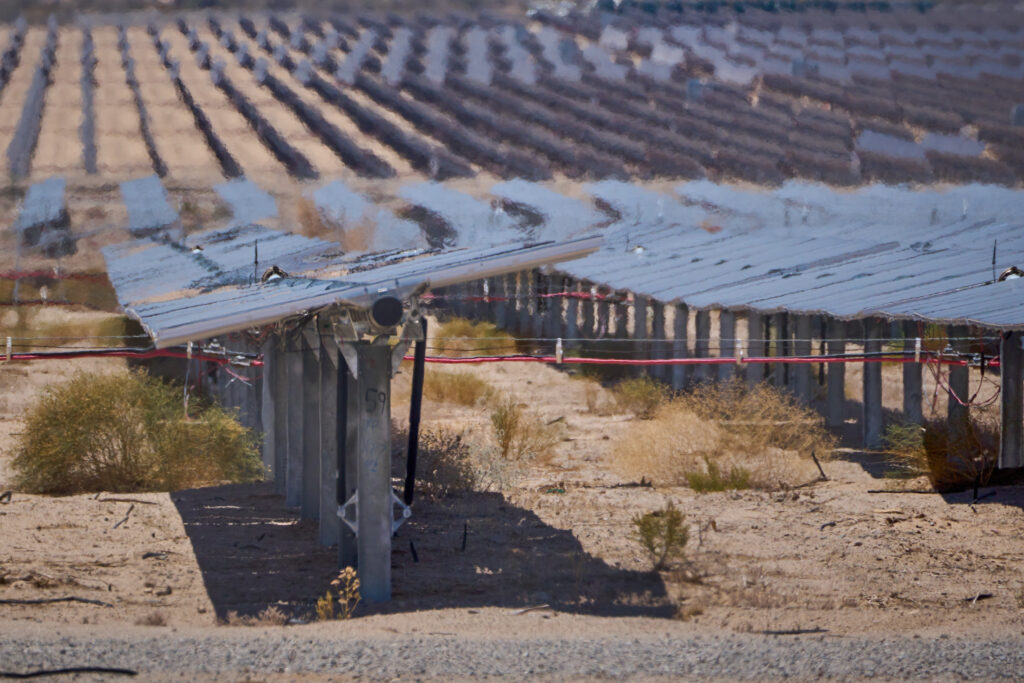
The county had worked with the state and federal governments to make the area a competitive renewable energy zone, he pointed out, and the plan before them was a good compromise. It had his support. The board approved the project unanimously, ending the six-hour meeting.
The Lake Tamarisk and Desert Center locals quietly walked out. They had known they faced an uphill battle, but thought they had a chance. At the very least, Carrington said the group “got a hesitation in there.”
But for some, it felt like their work had gone unnoticed, with the county making a decision to change the area where they live without even fully reading and understanding what the community was asking for.
Teresa Pierce, another Lake Tamarisk resident who has led the community’s fight, walked out of the county building with tears in her eyes. “We don’t have the money to keep fighting,” she said. She had spent two years reading through thousands of pages of environmental review documents and rallying a local coalition to save her stretch of the desert, rather than enjoying her retirement in it. It felt like a waste.
The county’s decision was just one part, Carrington said, and the big decision—from the Bureau of Land Management—was still to come, and they had more support in that process from environmental groups and even the Environmental Protection Agency.
In a letter from the EPA submitted to the BLM last month, the agency expressed its concerns over the Easley project’s “cumulative impacts to site hydrology, groundwater, air quality, biological resources and local communities.”
“We are particularly concerned about cumulative impacts to the western side of the Riverside East Solar Energy Zone and communities like Lake Tamarisk that continue to be directly impacted from solar development,” the EPA wrote in its letter.
The federal agency recommended the BLM conduct an environmental justice analysis while adding that the “Community Buffer” alternative for the project, which includes the community’s proposed one-mile setback, “appears to mitigate many potential direct and cumulative impacts.”
For the Active Community of Desert Center, it was just the sign they needed. The fight wasn’t over.
“Paying the Price”
Research from the Lawrence Berkeley National Laboratory has found communities tend to not mind living next to solar farms—until they exceed 100 megawatts, like the one proposed for Desert Center, where the negative opinions outnumber positive ones by about 12 to 1.
Robi Nelson, a postdoctoral researcher at the lab who helped lead that study and others looking at acceptance of renewable energy projects, said there’s increasing recognition of the role community engagement plays in the permitting of a project.
In one survey they conducted, community opposition was the third leading cause of a project’s cancellation. It also found solar projects were delayed by nearly a year because of opposition. One of the biggest lessons developers learned was to start community engagement earlier in the process. Most of the developers in the survey agreed community engagement is important and the public should provide input, but at the same time, said members of the public should not make recommendations or any decisions about a project. Ultimately, Nelson said, companies invest little attention or money in community outreach during projects, though there’s a growing perception of its importance.
Little is known about what community engagement strategies work best and how cost-effective they are, she said. “It’s hard to study these processes as they’re playing out in real-time.”
Cases like Desert Center are likely to multiply as the nation’s buildout of large solar projects accelerates and the land opened for renewable energy development grows, especially in the desert Southwest.
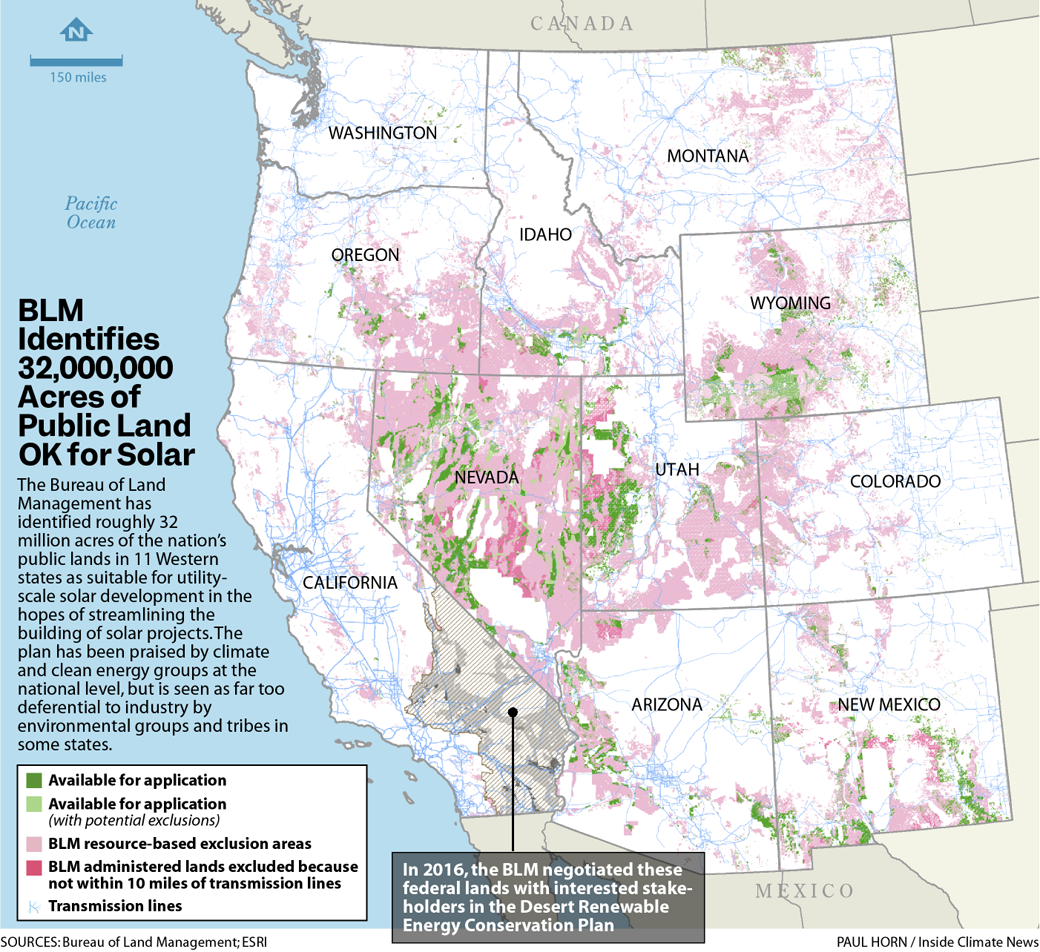
The Bureau of Land Management recently released the final environmental impact statement for the updated Western Solar Plan, which led to the creation of the solar energy zone around Desert Center. Under the proposed update more than 31 million acres of public lands across 11 western states would be open to solar development, although the BLM projects only around 700,000 acres will be built out.
“The updated Western Solar Plan is a responsible, pragmatic strategy for developing solar energy on our nation’s public lands that supports national clean energy goals and long-term national energy security,” said BLM Director Tracy Stone-Manning in a press release announcing the agency’s plan. “It will drive responsible solar development to locations with fewer potential conflicts while helping the nation transition to a clean energy economy, furthering the BLM’s mission to sustain the health, diversity, and productivity of public lands for the use and enjoyment of present and future generations.”
At the national level, the planning has been heralded by climate and energy groups as smart planning that can help steer development into agreed-upon areas. But locally, it’s been far more divisive because of the opened lands’ proximity to some communities and conflicts with culturally and environmentally sensitive landscapes. For some environmental groups, what’s happened at Desert Center highlights how things can go wrong.
This story is funded by readers like you.
Our nonprofit newsroom provides award-winning climate coverage free of charge and advertising. We rely on donations from readers like you to keep going. Please donate now to support our work.
Patrick Donnelly, the Great Basin director for the Center for Biological Diversity, said the planning leading Riverside County to become home to one of the biggest solar energy zones in the country saved millions of acres of land from development
“Unfortunately, the people at Desert Center are paying the price for all that,” he said. “If you took a couple hundred thousand acres off the table to put a buffer around communities, that could make a big difference in how the public feels about this.”
“To Suppress Input, Just Overburden a Community”
For the residents of Desert Center and Lake Tamarisk, engaging with the permitting of the area’s two proposed solar projects—Intersect Power’s Easley Project and EDF Renewables’ Sapphire Solar Project—has been overwhelming. Permitting for the county and the BLM is separate, and their processes take months if not years.
“If you want to have an excellent way to suppress input, just overburden a community,” Carrington said. “Give them 10,000 pages of stuff to read and see if they can handle it.”
In many communities, most residents may not have the time to get involved, said Nilson with the Lawrence Berkeley National Laboratory.
With the county’s approval secured, the project now moves on to get approval from the BLM, which oversees most of the land where the project will be built.
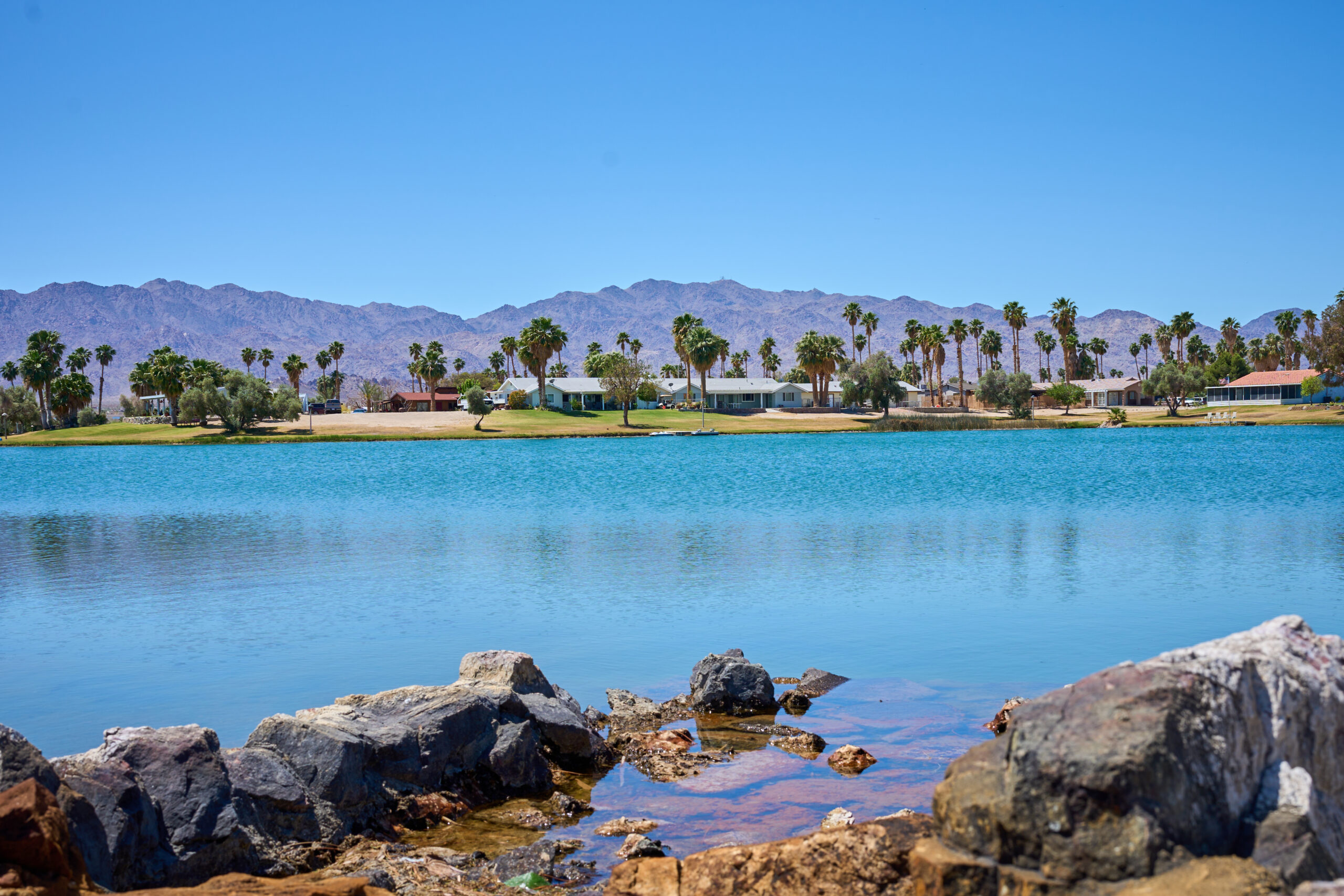
Elizabeth Knowles, director of community engagement at Intersect Power, said in a statement that the company remains “committed to engaging with the communities in Lake Tamarisk and Desert Center throughout the construction and operational life of the Easley project.”
The community still has concerns.
Residents worry about the project’s dust, the potential spread of Valley Fever from fungal spores that could be stirred up and their properties losing value. The project’s water assessment found it could result in a deficit of 300 acre feet of groundwater—typically enough for 600 California homes—meaning more water would be coming out of the local aquifer than goes in.
In a statement, Knowles said the deficit would be temporary, adding that their analysis “uses best available groundwater modeling for the Chuckwalla Valley Groundwater Basin and meets state and BLM requirements.” When Riverside County was asked about water concerns by Inside Climate News, officials declined to answer, instead referring to the environmental documents publicly available.
BLM staffers have long expressed concern over the amount of water available for solar development in the area and knew local wells could be impacted. The basin itself has been named a low-priority basin by California’s water department because of the limited population and growth in the area, existing wells and the groundwater conditions when the designation was given, but it has no jurisdiction over the projects as they are largely on federal land. Hydrologists who have spoken to Inside Climate News said there is not enough data on the basin to confidently assess groundwater supplies in the region. That’s something a hydrologist hired by locals found as well.
The hydrologist wrote he was “unable” to provide a “substantive review” to assess the basin because “foundational information” over how much water is available and how quickly it recharges were “absent.”
“County decision-makers cannot make a fully informed decision as to whether the Project would substantially decrease groundwater supplies such that the Project (or cumulative projects) may impede sustainable groundwater management of the basin.”
Locals have more hope for the BLM’s permitting process for the Easley project.
In recent weeks, using publicly available maps and documents, Carrington discovered a portion of Easley’s proposed site was in an area not designated for solar development that is big enough to provide the 965-acre buffer area residents have been asking for.
In 2022, when Intersect Power proposed the Easley Project, the designation of the lands was changed without an environmental review or public notice, according to the BLM. In a statement, a spokesperson said the agency had thought the area was privately owned, but learned it was public land overseen by the BLM and should be part of the solar energy development zone. So the agency changed the designation under what’s known as plan maintenance, which doesn’t require environmental review or public comment, as the revisions are typically minor.
But 965 acres, environmentalists and community members argue, is not minor. They point to the BLM conducting an environmental assessment and public comment period for a plan amendment to build a broadband communication site on just two acres of land in the county.
“It is a little fishy,” said Kevin Emmerich, a cofounder of the environmental group Basin and Range Watch who previously worked for the National Park Service and has worked with locals fighting the project.
The issue has also attracted the attention of other environmental groups, like CalWild, and letters from the EPA expressing concern over how the solar project will impact the community, something locals hope may help them get their buffer zone.
For now, the community waits. It will be months until a final environmental assessment is out, and even longer until a decision is made. And then they’ll do it all over again for the next solar project.
About This Story
Perhaps you noticed: This story, like all the news we publish, is free to read. That’s because Inside Climate News is a 501c3 nonprofit organization. We do not charge a subscription fee, lock our news behind a paywall, or clutter our website with ads. We make our news on climate and the environment freely available to you and anyone who wants it.
That’s not all. We also share our news for free with scores of other media organizations around the country. Many of them can’t afford to do environmental journalism of their own. We’ve built bureaus from coast to coast to report local stories, collaborate with local newsrooms and co-publish articles so that this vital work is shared as widely as possible.
Two of us launched ICN in 2007. Six years later we earned a Pulitzer Prize for National Reporting, and now we run the oldest and largest dedicated climate newsroom in the nation. We tell the story in all its complexity. We hold polluters accountable. We expose environmental injustice. We debunk misinformation. We scrutinize solutions and inspire action.
Donations from readers like you fund every aspect of what we do. If you don’t already, will you support our ongoing work, our reporting on the biggest crisis facing our planet, and help us reach even more readers in more places?
Please take a moment to make a tax-deductible donation. Every one of them makes a difference.
Thank you,
Search
RECENT PRESS RELEASES
Related Post


